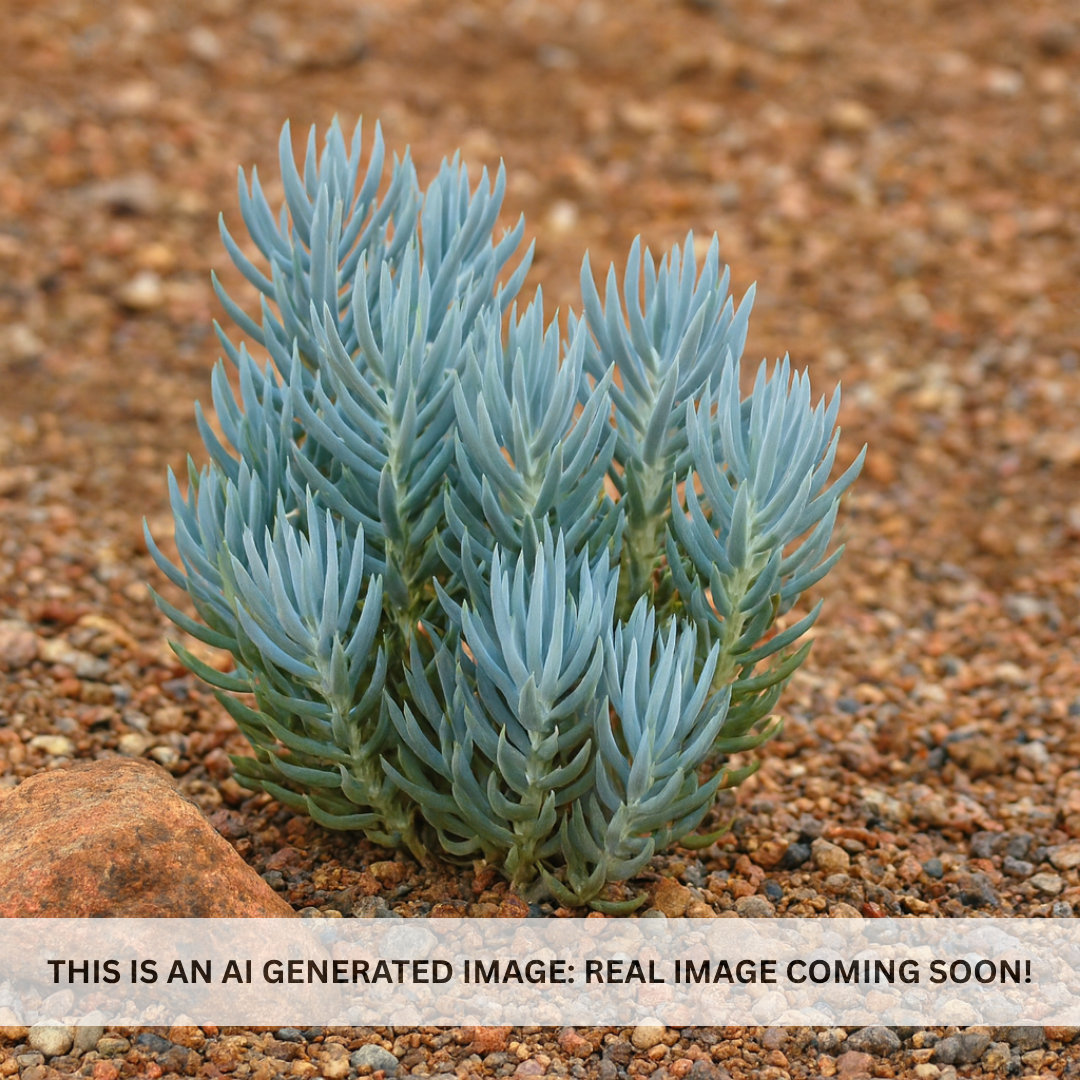My Store
Blue Fingers
Blue Fingers
Couldn't load pickup availability
Plant Type: perennial, evergreen succulent groundcover**
Plant Height: 12–18 inches (can reach 2 feet in bloom)**
Spread: 3–6 feet
Flower Color: creamy white
Sun Exposure: Full sun to light partial sun
Blue Fingers / Senecio mandraliscae: A Vivid Blue Carpet of Texture and Contrast
Senecio mandraliscae, commonly known as Blue Fingers, Blue Chalksticks, or Blue Chalk, is a striking, fast-spreading succulent native to South Africa. Renowned for its vibrant blue-gray foliage, dense, trailing habit, and modern, minimalist aesthetic, it’s one of the most popular low-water groundcovers used in Arizona landscapes.
In the intense desert light, its cool, powdery-blue color provides an essential contrast to warm rock and gravel tones—creating visual calm and sophistication. It’s both durable and decorative, thriving in full sun, poor soil, and drought conditions once established.
Key Features of Senecio mandraliscae
Blue Fingers forms dense mats of slender, finger-like leaves that grow upright before arching outward in soft, flowing clusters. The leaves are a rich silvery-blue with a chalky coating (a natural sunscreen that protects from UV rays).
In summer through early fall, it produces clusters of small, creamy-white flowers on stems that rise slightly above the foliage. The blooms attract pollinators, though the plant is primarily valued for its bold foliage color and clean, sculptural form.
Fast-growing and easy to shape, Blue Fingers spreads naturally to fill in spaces between rocks, slopes, and pathways, forming a living carpet that softens hardscapes and defines borders.
Growing and Care Tips
Senecio mandraliscae thrives in full sun and well-draining, sandy or rocky soil. In the Phoenix Valley, it prefers morning to midday sun and can tolerate reflected heat if established gradually. During the hottest months, partial afternoon shade helps maintain its best color and prevent leaf scorching.
Water deeply but infrequently during the first growing season—about every 10–14 days depending on heat and drainage. Once established, water only every 3–4 weeks in summer and rarely in winter. Overwatering is the most common cause of decline, leading to root rot or soft stems.
It’s cold hardy to about 25°F, tolerating light frost but suffering damage in prolonged freezes. In colder areas, it may die back and regrow from the roots in spring.
Pruning is minimal—simply trim leggy stems or remove spent flower stalks to maintain compact shape. The plant roots easily from cuttings, making it easy to propagate and expand across the landscape.
For containers, use a wide, shallow pot with gritty cactus mix, and avoid overwatering.
Landscaping Uses
Blue Fingers is a landscape designer’s favorite for its color, contrast, and texture. It’s ideal as a groundcover, border accent, or filler between agaves, cacti, and boulders. The cool blue tones make it invaluable for balancing the warm oranges, golds, and tans common in desert rock and stucco.
It’s excellent for slopes and erosion control, poolside planting, or modern courtyard landscapes, where it provides a soft, cohesive base layer under larger desert species. Pair it with Golden Barrel Cactus, Red Yucca, Aloe vera, or Blue Glow Agave for a balanced, high-contrast composition.
At night, under landscape lighting, its powder-blue foliage reflects a silvery glow—creating a tranquil, almost coastal feel in arid environments.
Summary
The Blue Fingers (Senecio mandraliscae) is a drought-tolerant groundcover that embodies desert simplicity and color harmony. Its soft blue foliage, fine texture, and resilient nature make it a staple for Arizona landscapes—cooling down warm desert tones while requiring minimal care. Perfect for homeowners and designers seeking color contrast, ground coverage, and year-round beauty in a waterwise garden.
Three Timbers Installation Guide (Feel Free to Follow):
Senecio mandraliscae Planting Guide:
Location: Full sun to light partial shade; prefers morning and midday sun with optional afternoon shade in extreme heat.
Soil: Use sharply draining soil composed of cactus mix, sand, and decomposed granite. Avoid clay-heavy soils.
Spacing: Allow 2–3 feet between plants for natural spread and coverage.
Planting Depth: Keep roots level with soil grade. Avoid burying crown or covering lower leaves.
Support: None required; spreads naturally by rooting along stems.
Watering Guide:
Watering After Planting: Water deeply once after installation to settle the soil. Then allow it to dry completely before watering again. During the first 3–4 months, water every 10–14 days depending on heat and drainage.
When is the Plant Established? Blue Fingers is considered established after 4–6 months, once new growth spreads and forms continuous clusters.
Watering Once Established: Water every 3–4 weeks during summer if no rainfall occurs. In winter, watering is rarely needed.
Drip Irrigation Setup: Install one low-flow emitter (0.5–1 gallon per hour) about 8–10 inches from the base. Run sparingly and allow full drying between cycles.
General Watering Tips: Always confirm soil dryness before watering again. Overwatering can cause stem collapse or root rot. A top dressing of decomposed granite or gravel enhances color contrast, improves drainage, and stabilizes the soil surface. Keep mulch or rock several inches from the plant base for airflow and long-term health.
Share












